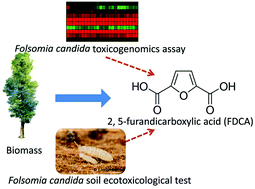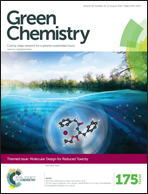The ecotoxicogenomic assessment of soil toxicity associated with the production chain of 2,5-furandicarboxylic acid (FDCA), a candidate bio-based green chemical building block†
Abstract
2,5-Furan dicarboxylic acid (FDCA) is one of the top-12 value-added chemicals derived from biomass that may serve as a ‘green’ substitute for terephthalic acid (TPA) in polyesters. FDCA can be synthesized chemically from 5-(hydroxymethyl)furfural (HMF), which is produced from fructose or glucose. To investigate the impact of the production chain of FDCA on the terrestrial ecosystem and unravel molecular pathways affected in animals, an ecotoxicogenomic study was performed to measure the transcriptome-wide response in soil invertebrates, namely Folsomia candida. First, we show that FDCA, HMF and TPA are biodegradable in natural soil. However, these chemicals can exert severe impact on the reproduction of F. candida in sterilized soil. Transcriptional changes were examined at EC50 concentrations of FDCA, HMF and TPA spiked in sterilized LUFA 2.2 soils. The results indicate that FDCA and TPA cause no significant changes in gene expression, which may be due to the low chemical water solubility and therefore slow uptake from the pore water. In contrast, a substantial number of genes were significantly regulated in F. candida after exposure to HMF. Gene ontology analysis showed many biological processes to be significantly affected, such as nucleic acid metabolism, the transcriptional metabolic process, cell developmental process and oxidation–reduction process. Moreover, the transcriptional profiles suggest that HMF might be biotransformed by F. candida into 5-sulfoxymethylfurfural (SMF) which is genotoxic and mutagenic. Current research shows that the environmental risk of the FDCA production chain from biomass is relatively low, but may only be affected by the release of the intermediate HMF compound.

- This article is part of the themed collection: Molecular Design for Reduced Toxicity

 Please wait while we load your content...
Please wait while we load your content...